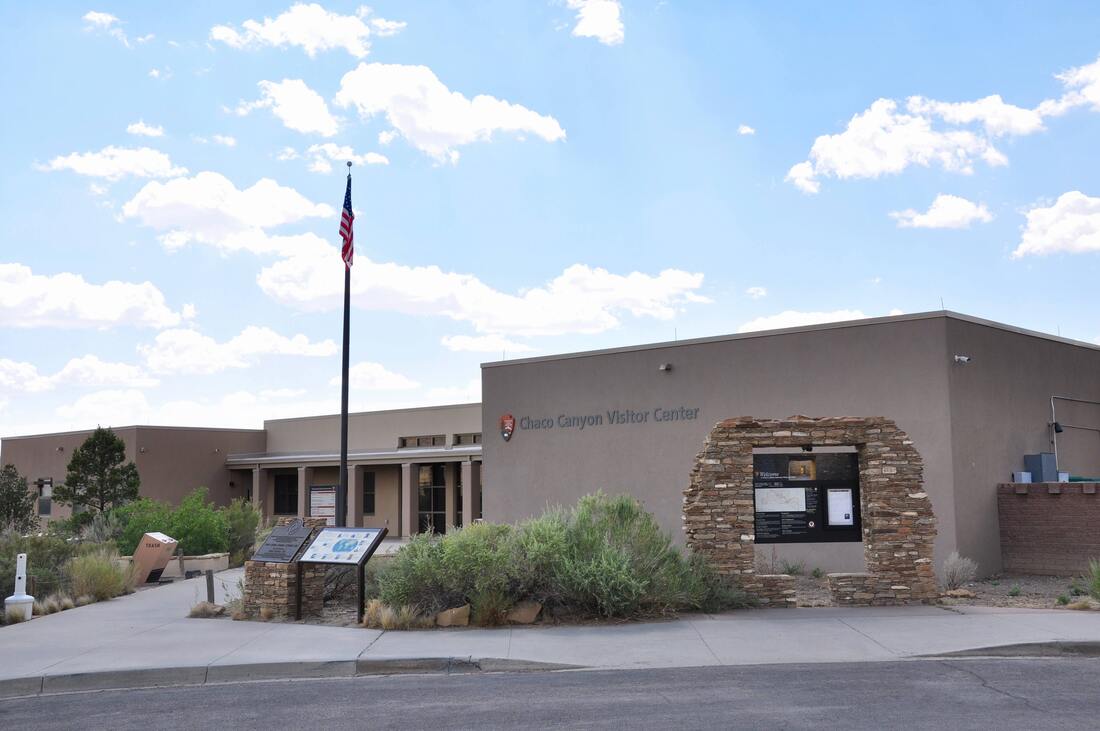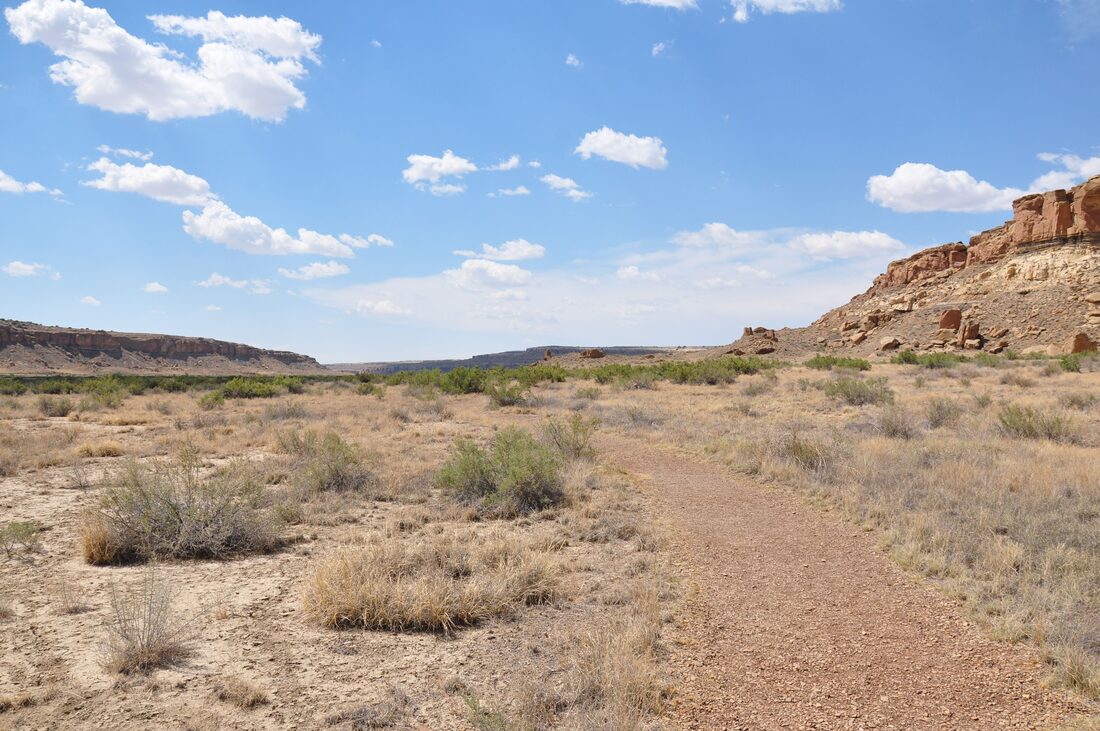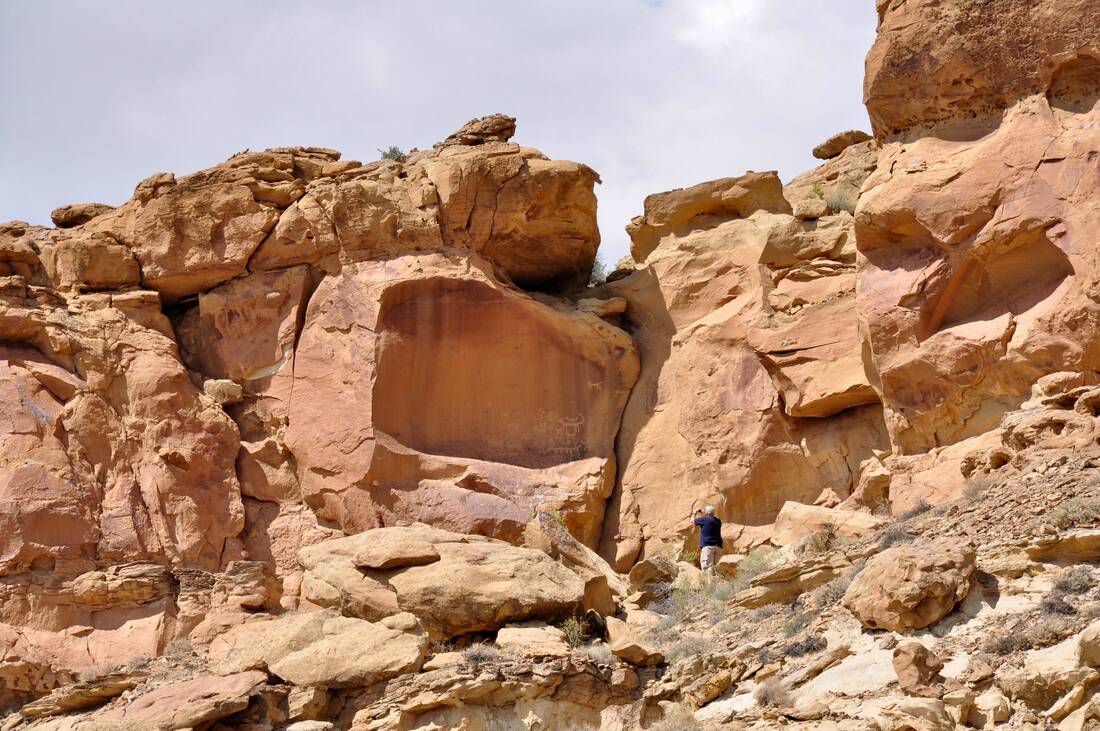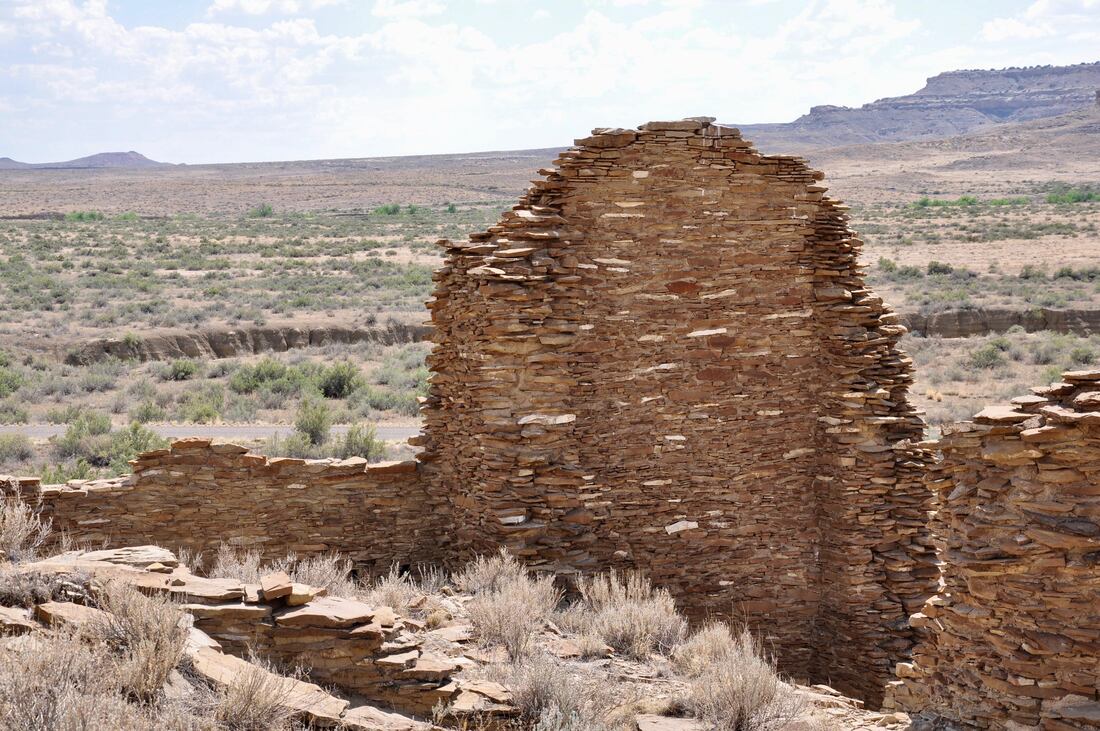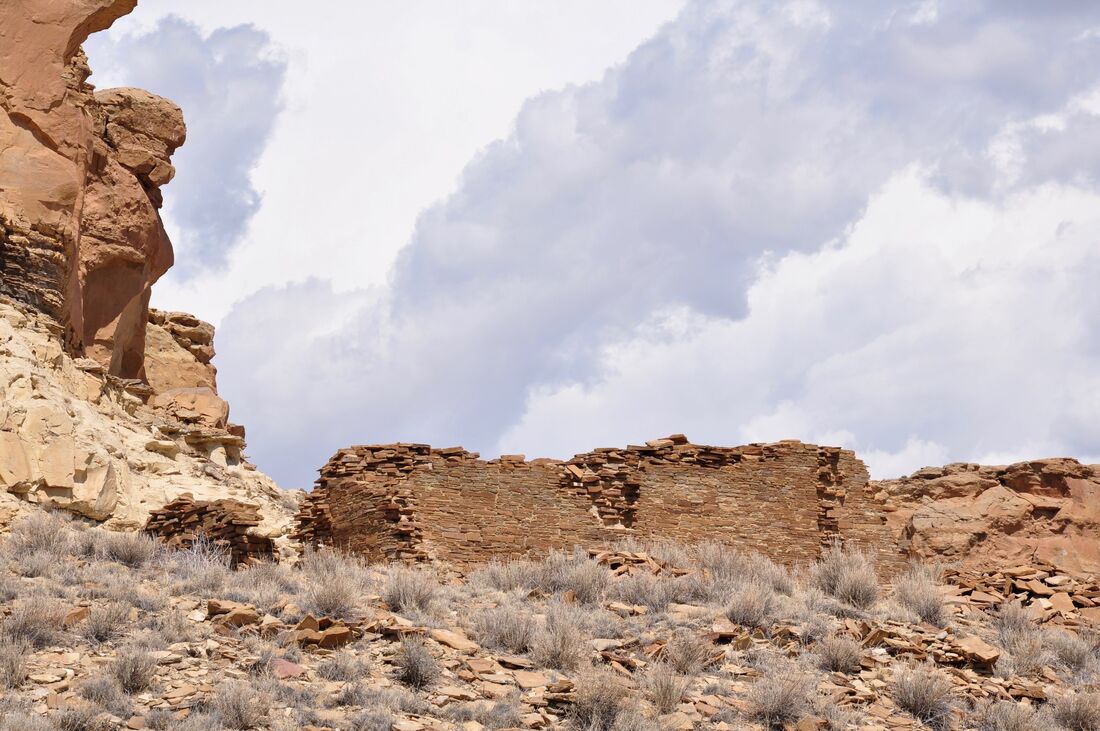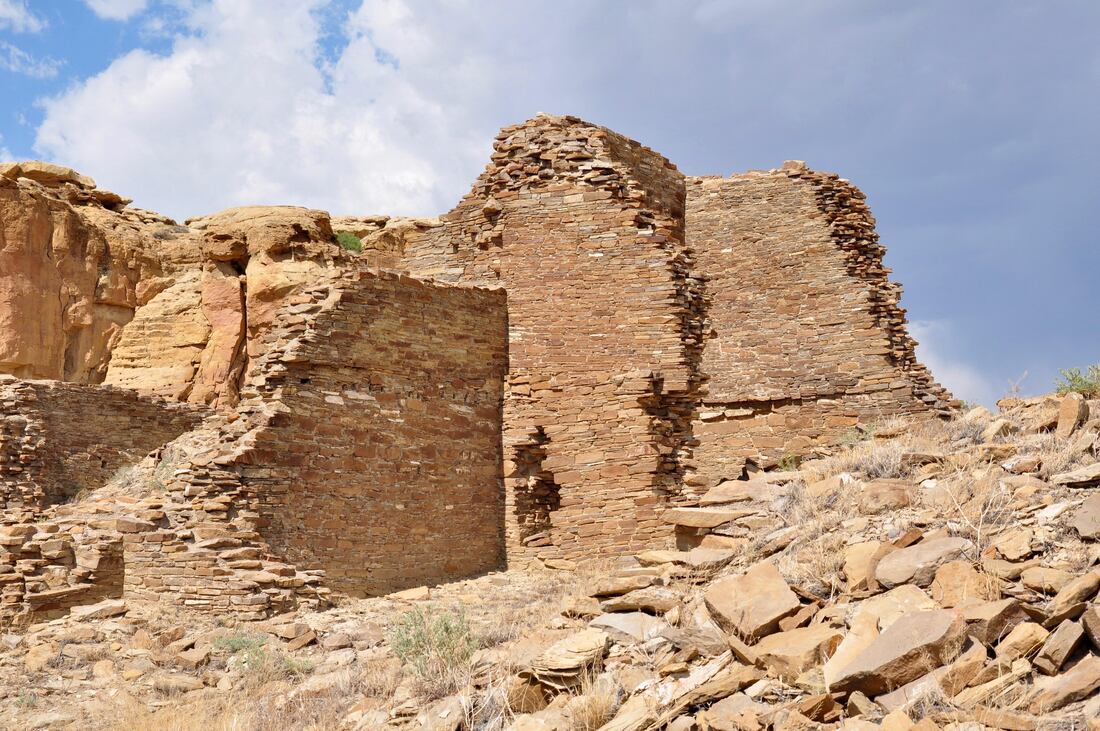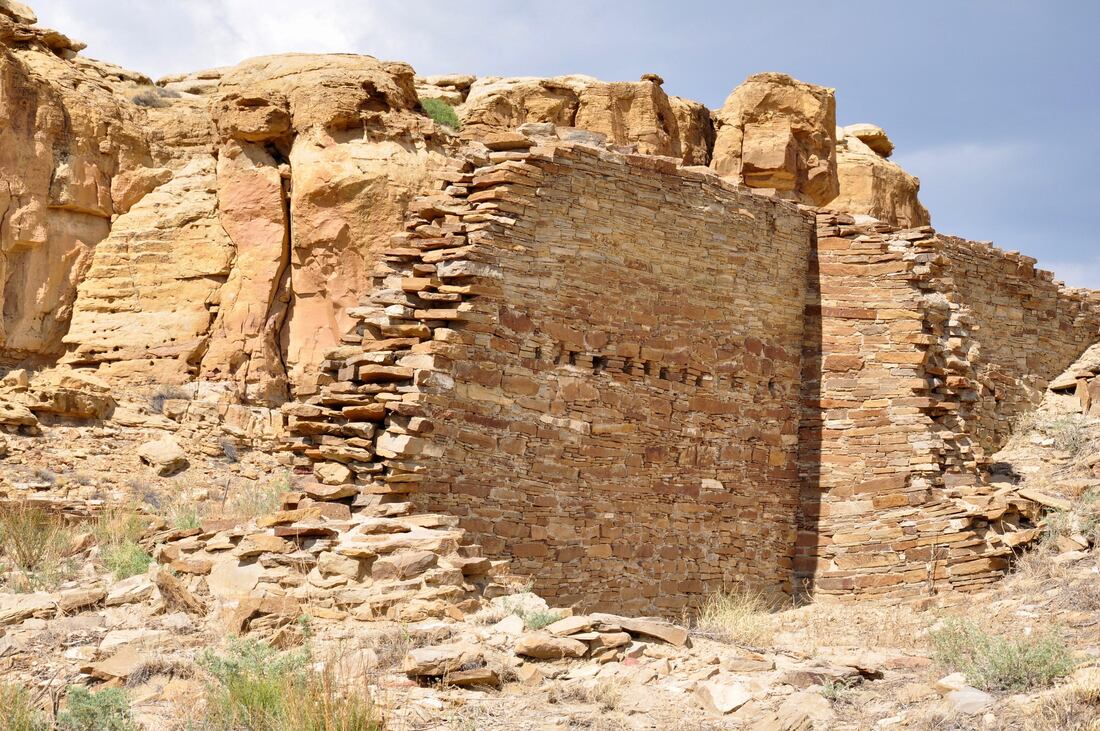|
The Chaco Culture National Historical Park happens to be one of the largest ancient archaeological sites in the west and there are many ancient pueblo structures within this sacred place. There actually is so much to see and experience in Chaco Canyon, that an entire week can be planned around this destination alone. To give an Idea of what lies in store, I have spend six days in Chaco Canyon and camped there overnight twice and there are still three hiking trails to ancient pueblos that I have not yet found the time to do! What this means is that it will take more than one week for a visitor to experience Chaco Canyon to the fullest extent, so Chaco is a place to return to time and time again. Chaco Canyon is in a very remote location and there are no large towns nearby. The closest towns that offer modern accommodations and services are Cuba, Farmington, Aztec, Bloomfield and Gallup. Each of these cities are about 70 miles away from Chaco Canyon, which means that plenty of daily travel time spent commuting back and forth to Chaco Canyon will have to be included in the vacation plan if modern amenities are required. Overnight camping at Chaco Canyon is the best option, but during the spring season the campground can be booked full. If the Chaco campground is full, other camping options can be found nearby in the Angel Peak Scenic Area on Highway 550 and in the neighboring Bisti/De-Na-Zin Wilderness. Camping in the nearby Navajo Nation recreation areas is an option too, but this requires gaining local tribal permission and a paying a small fee. For those who are coming from an easterly direction, the main access road from Highway 550 is a long 20 mile drive on a dirt road that may be too bumpy in some sections for low ground clearance vehicles, like sports cars and tiny economy cars. Regular size passenger car drivers can easily do the trip on the long dirt road, if they take it slow. A pickup truck or SUV is better suited for the 20 mile dirt access road. The Chaco Culture National Historic Park Visitor Center is where the entrance fees are collected and this is where tourists can become familiar with the ancient Chaco Culture. The visitor center is the start of all Chaco Canyon ventures and this is where detailed maps can be found for the foot trails and archaeological site locations. Many of the hiking trails and back country pueblos require registering for a permit, which is an uncomplicated matter that helps to protect this ancient sacred place. Most of the touring loop roadside pueblos require no permits to enter, but there are rules pertaining to where a visitor can tread upon the grounds. Staying on the foot trails is strictly enforced in this ancient sacred place, so it is best to become familiar with the National Park rules while in the visitor center. After becoming familiar with the history of Chaco Canyon in the visitor center, a visitor will not have to go far to find the first foot trail that leads to an ancient great house pueblo complex. The trail to the Una Vida Great House Pueblo is literally next door to the visitors center, so after paying the admission fee, a visitor can leave the vehicle parked in the lot and start right into exploring this ancient place! The foot trail to the Una Vida Pueblo is a one mile round trip hike over fairly level ground. This short hike will be easy for most people, but those who have mobility challenges may need assistance on the dirt trail. The only prerequisites needed for the short hike are a canteen of water and some sun protection. This is an arid high desert environment and dehydration can occur quickly, so it is best to take precautionary measures in order to last the entire day. Where there are tourists, there are big desert ravens preying upon handouts or anything shiny that they can grab. Navajo friends of mine laughingly refer to this large black raptors as being “Navajo Eagles” because they are so frequently seen in their tribal nation territory. The ravens definitely are the welcoming committee at Chaco Canyon and these birds have a unique way of remembering each individual person that they see. If you tease a raven it will look for opportunities to mess with you for the rest of the day, so if you want to be entertained, try doing a few raven bird calls while they are around and the ravens will return the favor during your visit when you least expect it. When approaching the Una Vida Pueblo Complex, only a few crumbled ruins can be seen, because the main body of this pueblo is hidden over the crest of a small hill. The first stone block ruins are a branching arm of the main pueblo complex structure, which actually is quite large. Una Vida is a “D” shaped pueblo complex, just like many of the other sites in this canyon. Because Una Vida was one of the very first built over 1,000 years ago, it is also one one of the most heavily eroded and much of this site remains in a natural state as unrestored ruins. There are foot trails that lead to the structures on the lower end of the hillside and some go around the top. From the high ground a visitor can see Una Vida in its entirety and from this vantage point the pieces of the puzzle fall into place. When looking down upon Una Vida, it is easier to see the original layout of this ancient pueblo complex, which covers plenty of ground. This structure was once over two stories tall and it had 160 rooms. Una Vida overlooks the mouth of the canyon and the views of the nearby eroded mesas across the valley are crystal clear. Una Vida is the closest great house pueblo to Fajada Butte, so the views of this Chaco Canyon landmark are as clear as day. The views extend for a great distance into the valley that runs south from Chaco, which was advantageous too. When standing by Una Vida, it does not take long to get the feeling of being in a sacred place where knowledge of the stars and the heavens were commonplace. There are a lot of mysteries involved with pondering the significance of the pueblo structures and the Chaco civilization which can only be answered in a meditational state, so it is best to plan on taking the time to envision how this ancient sacred place must have been way back in the day. In the dead silence of this native sacred place, the meditational visions provide a few answers to the mysteries of this place. Referring to the Chaco Canyon guide book pamphlet that can be purchased at the visitors center is another means of gaining insight, but for some people it is more satisfying to reach their own theoretical conclusions. Realizing that the ancient native communication networks once extended from South America all the way into the American Southwest does help to unravel a few mysteries of the past. Researching the ancient long distance paths and trade routes that pass through this region helps too. In the case of this region of New Mexico, all of the ancient Chacoan roads start in Chaco Canyon and they point straight out for a very long distance like the rays of the sun. This confirms that Chaco once was and still is a very important place that takes time to understand. One thing that many of the early archaeologists refused to do was to ask the local native people about what Chaco Canyon was all about, because the old timers preferred to become famous for stating their own opinions as factual matter. Fringe science participants also make the same mistake, by saying that the ancient people were not capable of building these fantastic structures without the assistance of extraterrestrial beings. Supposedly, aliens do play a role in some matters recognized in native lore, but so do other unknown civilizations, like the “Ant People” of the Sipapu underworld in the Grand Canyon. Researching the native lore associated with Chaco Canyon ahead of time will certainly enhance the experience when visiting this sacred place. Una Vida was one of the first structures built at Chaco Canyon back in ancient times and the trailhead is next to the visitor center, so this is the best place to start a touring venture. Taking one’s own sweet time is the best approach for experiencing Chaco Canyon, because there will be so much to ponder over when viewing the many great house pueblos in this area. Una Vida still stands tall over the valley below, waiting to tell its story to all that pass through this vast high desert expanse. All it takes is one look to see why so many people devote so much time to visiting this mysterious ancient sacred place!
0 Comments
Your comment will be posted after it is approved.
Leave a Reply. |
Leave no trace!
New!
Destination West YouTube channel! https://www.youtube.com/@DestinationWestOrg *The Destination West website upgrading project is well underway. Unique YouTube slideshows are replacing the outdated Flickr photo galleries. The new videos feature modern graphics and alternative music instrumentals that enhance the viewing experience. Some articles are being condensed, while others are getting much needed edits. As everybody knows, the bulk of the original articles and photos were published on the fly during the Covid camping venture and there were limitations. Upgrading is the way to go and more articles will receive a makeover each week until this project is completed. After that, I will be able to gather new material. There is light at the end of the tunnel!
JD Lane Archives
July 2024
Donations help the Destinaton West project continue into the future!
Go Fund Me! This website uses marketing and tracking technologies. Opting out of this will opt you out of all cookies, except for those needed to run the website. Note that some products may not work as well without tracking cookies. Opt Out of Cookies |

